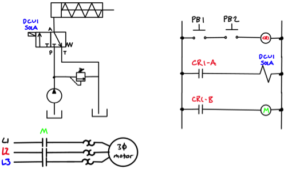6.1 Introduction to Electrically Controlled Systems
List basic applications of electrically controlled systems.
Give examples of inputs, outputs, and internal components in an electrically controlled system
Give examples of potential faults in an electrically controlled system
Differentiate between control/pilot signal and power/primary signals
Describe the purpose of separating pilot and primary
Describe the purpose of a control transformer
Describe the similarities and differences between a contactor and a solenoid operated valve
Describe ladder logic diagrams and indicate the advantages of ladder logic
List the general rules of ladder logic
Differentiate between switches and sensors
Describe the purpose of a transducer
Differentiate between manual and mechanical/automatic switches and give examples of each
Describe span/hysteresis/override
Differentiate between hard wired relay based ladder logic and PLCs and discuss the advantages of PLCs
Describe a control relay
Describe the AND function
Describe the OR function
Describe the operation of this electrically controlled system.
Discuss general troubleshooting procedures for electrically controlled systems.


